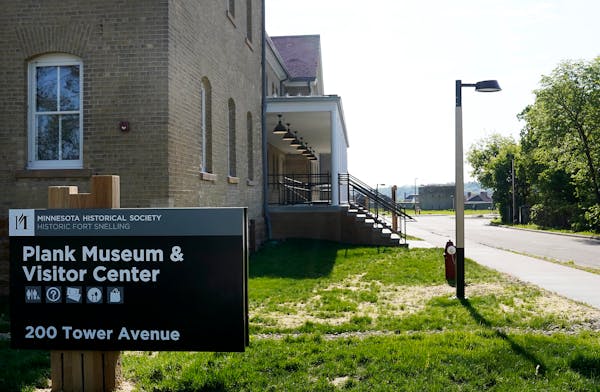The Minnesota Historical Society has decided against renaming Historic Fort Snelling after controversy a few years ago when the organization temporarily added "at Bdote" to signs — the name the Dakota people have long used to refer to the sacred place at the confluence of the Minnesota and Mississippi rivers.
On Thursday, the nonprofit's governing board unanimously approved keeping the existing name, saying there wasn't "conclusive" feedback from public input meetings held in 2019 to explore whether to rename the historic site — not the fort itself — to better reflect the history of the Dakota people and other diverse stories.
"They have failed to even include or incorporate Indigenous history," said Ramona Kitto Stately, a member of the Santee Sioux Dakota Nation who leads public tours of the area, organized by the Minnesota Humanities Center. "[Adding Bdote] is a way of acknowledging the harm perpetuated to a group of people who are still here. ... We're still invisible to them and I think those decisions are made out of fear."
In 2019, some Republican legislators were upset that the Historical Society had added temporary signs reading "Historic Fort Snelling at Bdote" and threatened to cut state funding to the nonprofit. State Sen. Mary Kiffmeyer, R-Big Lake, who authored the cuts, said then that Fort Snelling should only celebrate the state's military history. Others said the Historical Society was being "revisionist."
"They caved to being threatened by financial loss," Stately said Friday about the nonprofit's decision. "What we'd really like is our land back. ... Naming it would have been a nice first step."
In a statement Friday, the Historical Society said it "continues to be committed to sharing an expanded and more complete history of the 10,000 year old historic site including Bdote, the Dakota homeland, as well as the history of African Americans, Japanese Americans, women, veterans and soldiers who passed through Historic Fort Snelling for decades."
The organization took down the temporary signs in 2019, saying that, while the official name hadn't changed, it led to "public confusion" that the name was now "Fort Snelling at Bdote." The nonprofit sought public input. More than 7,000 people filled out an online survey and about 160 people attended six input meetings held statewide.
In a new 113-page report about the process — which was delayed because of the pandemic and layoffs at the organization — the Historical Society said there was "no strong consensus" about renaming the historic site. About half of respondents wanted to keep the current name while about half favored adding or replacing the name with Native American words, or a completely new name.
"It's disappointing but it's not surprising," said the Rev. Jim Bear Jacobs, co-director for Racial Justice at the Minnesota Council of Churches, who is a member of the Stockbridge-Munsee Mohican Nation in Wisconsin and also leads tours of sacred sites.
He said it was a missed opportunity to add "Bdote" to the name, and continues a "legacy of intentional Indigenous erasure." Unlike the controversy surrounding the renaming of Minneapolis' Lake Calhoun to its Dakota name, Bde Maka Ska — thus cutting ties with a Southern politician who supported slavery — many respondents weren't seeking to cut Snelling but instead to add a Native American name.
"It's not a renaming; it's adding a location," Jacobs said. "It just gives the context that Fort Snelling exists in a sacred Indigenous space."
If the Historical Society's governing board had recommended a name change or reconsiders one in the future, it would go to the Legislature for a vote.
The fort, which is on about 4 of 23 acres of the larger historic site, was built in the 1820s. It was briefly called Fort St. Anthony before being renamed after Col. Josiah Snelling, who oversaw its construction. It remained an active military base until 1946. In 1960, the fort was designated a national historic landmark, the first in Minnesota.
In recent years, the Historical Society has added programs and exhibits to broaden the telling of the state's history through the lens of more diverse communities — from slaves who lived at the fort to Japanese-American soldiers who trained there and the Dakota who lived there for centuries before white settlers came. The fort was also the site of a concentration camp for 1,600 Dakota following the U.S.-Dakota War of 1862.
"I applaud the Historical Society for more recently coming to terms with that history," Jacobs said, though he added that "it's ridiculous" that adding "Bdote" stirred any controversy or debate.

Want to share info with the Star Tribune? How to do it securely

'Safe recovery sites' would offer syringes, naloxone and more to people using drugs. The plan could be in peril.
New Minnesota GOP leaders seek peace with party's anti-establishment wing

Who is Republican Lisa Demuth, Minnesota's first House speaker of color?

